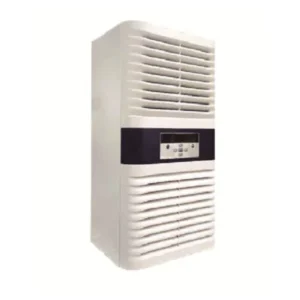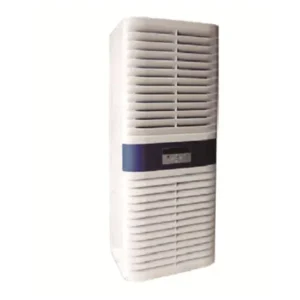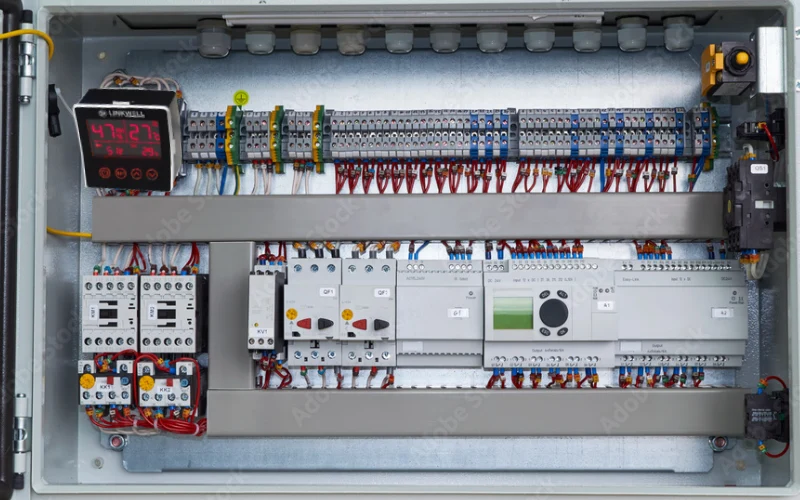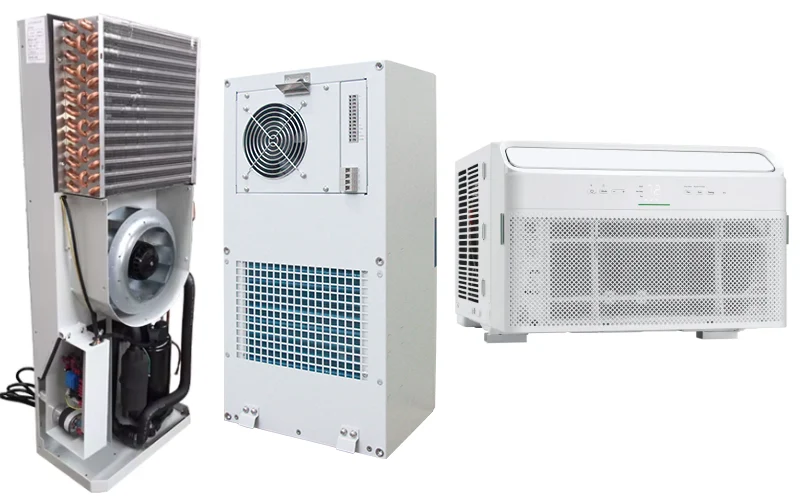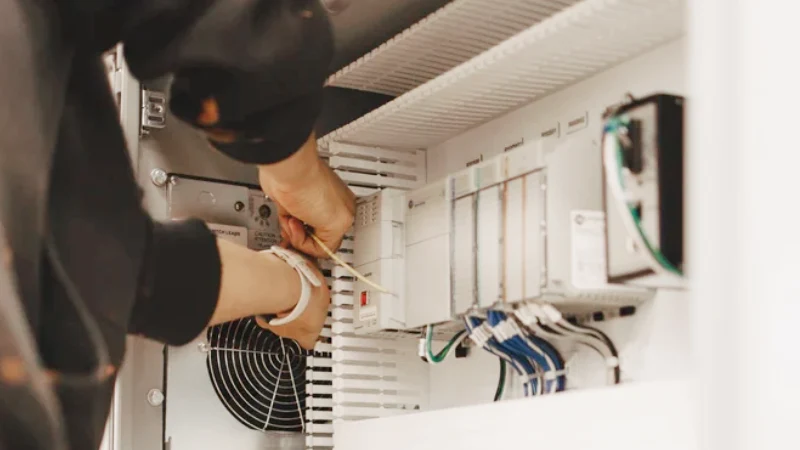So, what is txv in air conditioning? The thermostatic expansion valve, or txv, acts as a control device that manages how much refrigerant flows into your system’s evaporator coil. When you have a txv in your HVAC systems, you get more precise temperature control and greater comfort at home. Here’s what makes txvs so valuable:
- They help your air conditioner use less energy by stopping too much refrigerant from entering the system.
- You get better cooling performance because the txv adjusts to what your system needs.
- Modern txvs give you accurate refrigerant control, which means you avoid wasting energy.
That’s why you’ll find advanced TXV technology in high-quality products like Linkwell’s Cabinet Air Conditioner.
Key Takeaways
- The TXV controls refrigerant flow, improving energy efficiency and comfort in your air conditioning system.
- Regular maintenance of the TXV can prevent costly repairs and extend the lifespan of your HVAC system.
- A faulty TXV can lead to poor cooling performance and increased energy bills; watch for signs like ice on coils or strange noises.
- Choosing a system with advanced TXV technology, like Linkwell’s Cabinet Air Conditioner, ensures reliable cooling and protects sensitive equipment.
What Is TXV?
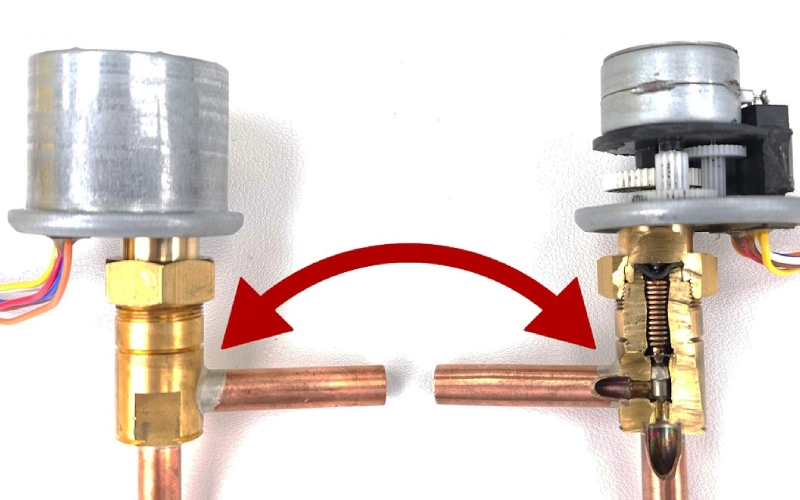
TXV Meaning in HVAC
If you have ever wondered what is txv, you are not alone. In HVAC systems, a txv, or thermostatic expansion valve, is a small but powerful device that helps your air conditioner run smoothly. You will find it in both home and industrial cooling systems. Here is what you need to know:
- A thermostatic expansion valve (TXV) is a device used in refrigeration and air conditioning systems.
- It controls the amount of refrigerant liquid that is injected into the evaporator.
- The operation is based on the temperature and pressure at the evaporator outlet, known as superheat.
When you look at a txv, you see a few main parts working together. Each part has a job that helps your air conditioner keep things cool and efficient. Check out this table to see how each component works inside the txv thermal expansion valve:
| Component | Function |
|---|---|
| Inlet | Lets high-pressure refrigerant enter the TXV. |
| Outlet | Releases refrigerant as a low-pressure, low-temperature vapor/liquid mixture. |
| Power Head | Controls refrigerant flow based on pressure from the sensing bulb. |
| Capillary Tube | Sends pressure changes from the sensing bulb to the Power Head. |
| Sensing Bulb | Measures superheat at the evaporator outlet to adjust refrigerant flow. |
| Diaphragm | Moves to regulate refrigerant flow based on pressure from the sensing bulb. |
| Removable Cartridge | Contains an orifice that works with the valve to control refrigerant flow. |
You might hear people call it a thermal expansion valve, but it means the same thing. The txv thermal expansion valve keeps your system running at the right temperature by making sure just the right amount of refrigerant gets through.
Role of the Thermostatic Expansion Valve
So, what does a txv actually do in your air conditioner? You can think of it as the traffic cop for refrigerant. It decides how much refrigerant goes into the evaporator coil, which is where the cooling magic happens.
The thermostatic expansion valve is designed to respond to the temperature of the unit’s evaporator coil. A special thermal bulb will read the conditions and cause the valve to open wider as the temperature rises. This function permits a greater amount of refrigerant to enter the coil, thereby enabling it to better meet a given cooling task.
When your air conditioner needs to cool more, the txv opens up and lets more refrigerant flow. If the system does not need as much cooling, the txv closes a bit, slowing down the flow. This smart control helps your system stay efficient and keeps your home or equipment at the perfect temperature.
A thermostatic expansion valve (TXV) is a small HVAC part that plays a big role in air conditioning systems. This valve regulates the flow of refrigerant entering the evaporator during the refrigeration cycle.
The txv thermal expansion valve also protects your system. It measures the superheat at the outlet and adjusts the refrigerant flow to keep that superheat steady. The sensing bulb makes sure only superheated vapor enters the compressor, which helps prevent damage. The diaphragm and spring inside the txv work together to adjust the superheat based on how much cooling you need.
You will find the hvac txv in many modern air conditioning systems, including advanced products like Linkwell’s Cabinet Air Conditioner. These systems rely on the txv to deliver reliable, efficient cooling every day.
How Does a Thermal Expansion Valve Work?
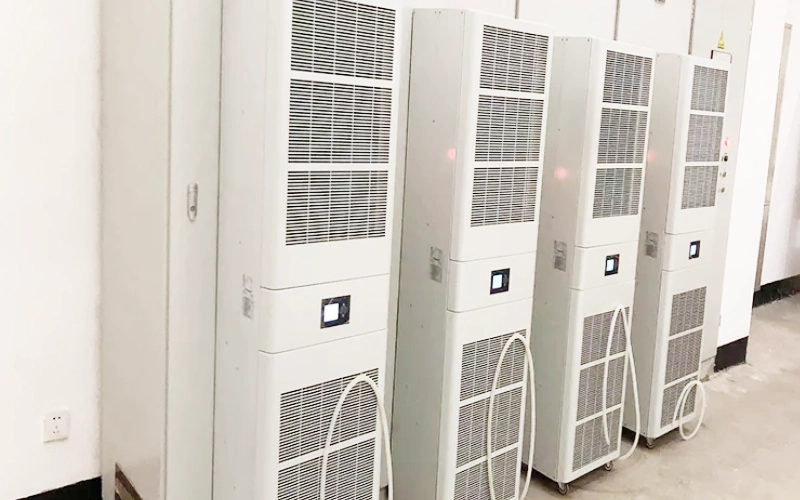
Regulating Refrigerant Flow
When you look at how a txv works, you see a smart device that knows exactly how much refrigerant your system needs. The txv thermal expansion valve sits at the entrance to the evaporator coil. Its job is to control the flow of refrigerant so your air conditioner can cool things down efficiently.
Here’s what happens inside the txv thermal expansion valve:
- A sensing bulb, filled with a special gas or liquid, attaches to the outlet of the evaporator. This bulb reacts to temperature changes.
- When the temperature at the bulb rises, the pressure inside increases. This extra pressure pushes against a diaphragm inside the valve.
- The valve opens wider, letting more refrigerant flow into the evaporator coil.
- If the temperature drops, the pressure in the bulb falls. The valve closes a bit, reducing the flow of refrigerant.
This process keeps the right amount of refrigerant moving through your system. The txv thermal expansion valve also keeps an eye on superheat. Superheat is the difference between the temperature of the refrigerant vapor and its boiling point at the evaporator pressure. By regulating superheat, the txv makes sure the refrigerant is fully vaporized before it leaves the coil. This step protects your compressor from damage and keeps your air conditioner running smoothly.
Tip: If you want your HVAC systems to last longer and work better, make sure the txv is working properly. It’s a small part, but it makes a big difference.
TXV and System Efficiency
You might wonder why the txv matters so much for efficiency. The answer is simple: it helps your air conditioner use energy wisely. The txv thermal expansion valve responds to changes in cooling demand. When your system needs more cooling, the valve opens up. When less cooling is needed, it closes down. This constant adjustment means your system never wastes energy by sending too much or too little refrigerant through the coil.
Let’s break down how the txv boosts efficiency in your HVAC systems:
- The txv can regulate refrigerant flow much better than fixed orifice devices. Fixed orifices just meter the flow, but the txv throttles it to keep the evaporator at a steady temperature.
- By keeping the superheat at the right level, the txv ensures the refrigerant is always in the best state for cooling. This means your system can reach optimal efficiency.
- The txv helps reduce compressor cycling. When the compressor doesn’t have to turn on and off as often, you save energy and reduce wear on your equipment.
Here’s a quick look at how the txv helps your system run better:
| Contribution of TXVs | Description |
|---|---|
| Regulates refrigerant flow | TXVs manage refrigerant flow over a wide range of load conditions, ensuring optimal performance. |
| Manages compressor temperature | They keep the compressor temperature within a smaller range, enhancing efficiency. |
| Shuts off refrigerant flow | TXVs can stop refrigerant flow when the compressor is off, maintaining pressure in the liquid line for quick restart. |
If you use a txv in your air conditioning or refrigeration system, you get more reliable cooling and lower energy bills. That’s why you’ll find the txv thermal expansion valve in advanced products like the Linkwell Cabinet Air Conditioner. These units rely on the latest txv technology to deliver steady, efficient cooling—even in tough environments.
So, when someone asks, “what is txv?” you can tell them it’s the key to smarter, more efficient cooling. The thermostatic expansion valve keeps your system balanced, protects your compressor, and helps you get the most out of your HVAC txv setup.
Benefits of HVAC TXV
Energy Efficiency and Comfort
When you think about what is txv, you probably want to know how it helps you save energy and stay comfortable. The txv thermal expansion valve gives your air conditioner the power to adjust the flow of refrigerant based on real-time cooling needs. This means your system does not waste energy by sending too much refrigerant through the coil. Instead, it keeps everything balanced for top performance.
Here’s a quick look at how the txv makes a difference:
| Benefit | Description |
|---|---|
| Improved efficiency | TXVs control refrigerant flow, ensuring maximum system efficiency, reducing energy consumption. |
| Enhanced system performance | Maintains consistent temperatures and humidity, improving occupant comfort. |
| Reduced energy consumption | Operates the evaporator at optimal superheat, minimizing compressor workload and energy use. |
You get steady temperatures and better humidity control. The txv thermal expansion valve helps your air conditioner run smoother, so you feel more comfortable at home or at work. Most of the time, your system does not need full cooling power. The txv senses this and cuts back, which leads to less strain on your compressor and lower energy bills. That’s one of the biggest benefits of an expansion valve.
System Protection and Longevity
The txv does more than just boost energy efficiency. It also protects your HVAC systems from damage. By carefully managing the flow of refrigerant, the txv thermal expansion valve stops liquid refrigerant from reaching the compressor. This helps prevent a problem called floodback, which can ruin your compressor over time.
- The txv only lets enough refrigerant into the evaporator to be fully vaporized.
- If the system load drops, the valve adjusts, so the compressor never gets hit with liquid refrigerant.
- With proper care, a txv can last 10 to 15 years, keeping your system running strong.
You get peace of mind knowing your equipment will last longer and need fewer repairs. The txv thermal expansion valve is a small part, but it plays a huge role in system protection.
Linkwell Cabinet Air Conditioner Applications
If you want reliable cooling for sensitive electronics, you need a system that uses advanced txv technology. Linkwell’s Cabinet Air Conditioner is a great example. These units use a txv to deliver precise temperature control and energy efficiency, even in tough environments. You get steady cooling, lower power use, and longer equipment life.
Linkwell’s cabinet air conditioners use the latest txv thermal expansion valve designs to keep your enclosures safe and cool. You can trust these systems to protect your valuable electronics and keep your operations running smoothly.
When you choose a product like Linkwell’s, you get all the benefits of an expansion valve—energy savings, comfort, and system protection—built right in.
Recommended products
Common TXV Issues
Signs of TXV Failure
You might notice when your air conditioner just does not cool like it used to. Sometimes, the problem comes from the txv. The txv thermal expansion valve can fail in a few different ways. If you pay attention, you can spot the signs early and avoid bigger problems.
Here are some common signs that your txv is not working right:
- The air coming from your vents feels warmer than usual.
- Your system runs longer but does not cool the space well.
- You hear strange hissing or bubbling noises near the evaporator coil.
- Frost or ice builds up on the evaporator coil or refrigerant lines.
- The compressor turns on and off more often than normal.
If you see these symptoms, your txv might be stuck open or closed. Sometimes, debris or moisture can block the valve. Other times, the sensing bulb loses its charge. When you notice these issues, you should call a professional for a checkup. Quick action can save you from a full txv replacement.
Tip: Regular maintenance helps keep your txv thermal expansion valve in top shape. Clean filters and coils can prevent many common problems.
Impact on Performance
A faulty txv can really hurt your air conditioner’s performance. When the txv does not control the refrigerant flow correctly, your system cannot cool as it should. You might feel uncomfortable, and your energy bills can go up.
Here’s what can happen if your txv fails:
- Cooling capacity can drop by up to 20%. Your system just cannot keep up with the heat.
- Efficiency, measured as the coefficient of performance (COP), can fall by as much as 34%. You use more energy for less cooling.
- If more than one fault happens at once, the impact can get even worse. Sometimes, the error in fault analysis can reach up to 25%.
You want your hvac systems to run smoothly and efficiently. If you ignore txv problems, you risk higher costs and more wear on your equipment. Keeping an eye on your txv and fixing issues early helps your system last longer and keeps you comfortable.
TXV vs Other Expansion Valves
Fixed Orifice vs Thermostatic Expansion Valve
You might wonder how a fixed orifice device stacks up against a txv. Fixed orifices work well when conditions stay the same, but they struggle when things change. The txv thermal expansion valve adapts to different loads, giving you better temperature control and protecting your equipment. Here’s what you get with a txv:
- Up to 11% higher SEER ratings compared to fixed orifice devices.
- More consistent comfort and energy savings.
- Better protection for your compressor and system.
The Department of Energy now requires more advanced metering devices, showing how important energy efficiency is in modern HVAC systems. If you want your air conditioner to keep up with changing conditions, the txv is the smarter choice.
Electronic Expansion Valve vs TXV
Electronic expansion valves (EEVs) are becoming more popular, especially in new HVAC systems. Over 65% of new installations use EEVs because they offer precise control and better energy efficiency. Let’s look at how EEVs compare to the txv thermal expansion valve:
| Type | Advantages | Disadvantages |
|---|---|---|
| EEV | Precision control, energy savings, adaptability, reduced compressor load, enhanced superheat control | Complex installation, higher cost, sensitive maintenance |
| TXV | Reliable, cost-effective, low maintenance, proven technology, consistent performance | Limited precision, slower response, less suitable for complex systems |
EEVs work best in complex or high-tech setups. The txv still shines in simpler systems where reliability and ease of use matter most.
Choosing the Right Valve for Your System
Picking the right expansion valve depends on your needs. You should think about system size, performance goals, and operating conditions. Here are some key factors:
| Factor | Description |
|---|---|
| Valve Sizing | Make sure the valve matches your system’s capacity. |
| System Performance | Choose a valve that keeps your system running smoothly. |
| Energy Efficiency | The right valve can lower your energy bills and extend equipment life. |
| Operating Conditions | Consider things like subcooling and pressure drops. |
| Manufacturer Guidelines | Always follow the manufacturer’s advice for best results. |
Linkwell’s Cabinet Air Conditioner uses advanced expansion valve technology. Smart controls adjust refrigerant flow in real time, keeping temperatures steady and protecting your electronics. Unlike standard txvs, Linkwell’s system prevents overcooling or undercooling, saving energy and boosting reliability.
Tip: If you want top performance and long-lasting protection for your equipment, look for systems that use smart expansion valve technology like Linkwell’s.
You now know why the TXV matters in your air conditioning system. It keeps your cooling steady and efficient.
With a high-quality TXV, your HVAC system can maintain more consistent indoor temperatures and humidity levels. This results in a more comfortable living or working environment, free from the temperature swings and inefficiencies that can occur with inferior refrigerant control.
Choosing a system like Linkwell’s Cabinet Air Conditioner means you get reliable performance and peace of mind.
- TXVs adjust refrigerant flow for the best cooling and dehumidification.
- A faulty TXV can cause poor cooling or even a system shutdown.
If you notice ongoing cooling issues or ice on your coil, call a professional. Regular checkups help your system last longer and work better.
FAQ
What does a TXV do in my air conditioner?
A TXV controls how much refrigerant enters the evaporator coil. You get better cooling and energy savings because the valve adjusts flow based on your system’s needs. This helps your air conditioner run smoother and last longer.
How can I tell if my TXV is failing?
Look for signs like weak cooling, ice on the coil, or strange hissing noises. If your system runs longer but cools less, the TXV might have a problem. You should call a technician if you notice these issues.
Do I need to maintain the TXV?
You do not need to service the TXV itself often. Just keep your filters and coils clean. Regular maintenance helps the TXV work properly and keeps your whole system efficient.
Can a TXV improve energy efficiency?
Yes! A TXV helps your air conditioner use less energy by sending the right amount of refrigerant to the coil. You save money on your energy bills and enjoy more consistent comfort.
Why does Linkwell use TXV technology in cabinet air conditioners?
Linkwell uses TXV technology to give you precise temperature control and reliable cooling. This protects sensitive electronics inside cabinets and helps your equipment last longer, even in tough environments.

